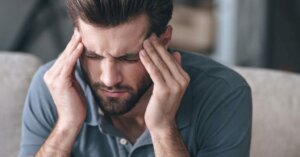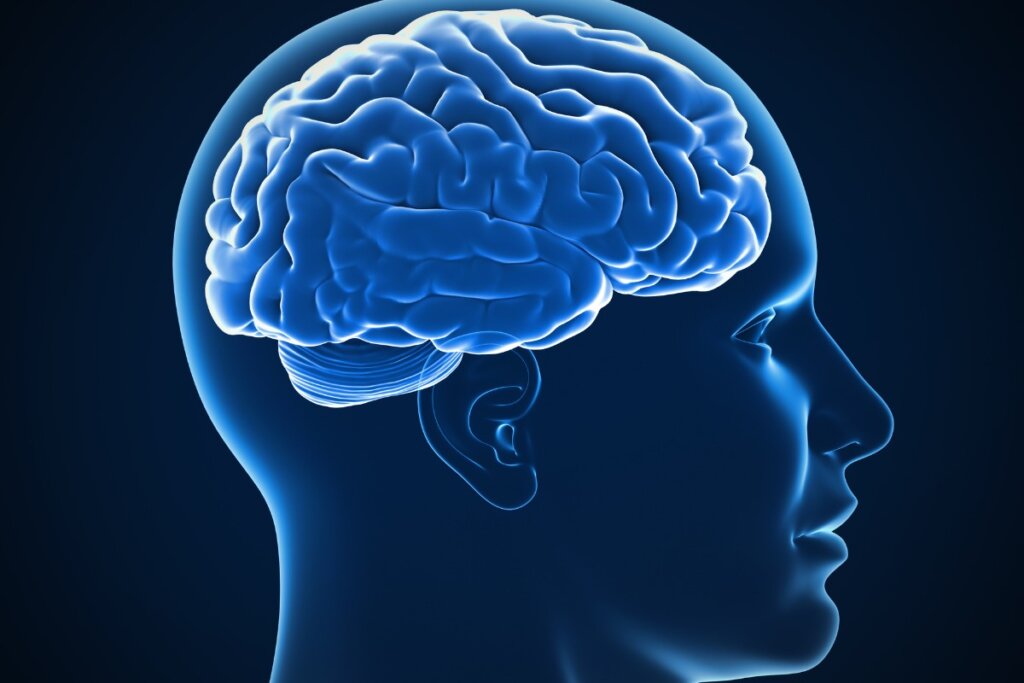Dehiscence Syndrome: Hearing Your Eyes Move and Your Blood Circulate


Written and verified by the psychologist Valeria Sabater
The way in which sufferers from dehiscence syndrome describe their symptoms, it’s as if they were living in an Edgar Allan Poe story. In fact, those who suffer from this condition report hearing the sound of their eyeballs moving inside their sockets. They also claim to hear their blood circulating, the movements of their bones as they chew, and the beating of their heart.
This is a rare condition of the middle ear that affects one or two percent of the population. The origin lies in the incomplete development of the bones of the head. By not reaching its normal thickness, the cranial cavity is more fragile and also more susceptible to erosion. This can generate a number of problems. Among them is the appearance of a gap in the temporal bone that causes the symptoms of dehiscence syndrome.
Patients can lead normal lives until, at a certain point, in their 40s or 50s, they begin to hear unexplained internal sounds. These are so strange that many describe it as if, every time they move their eyes, it feels like sandpaper is rubbing against them. As a matter of fact, this medical reality is so strange that to start with, mental problems are often considered to be the cause.
However, after performing a computed tomography, the true reality is revealed. Although the syndrome is really rare, treatment is available and patients can recover their quality of life. Let’s take a closer look.
Many people experience superior canal dehiscence syndrome after suffering a head injury.

Dehiscence syndrome: characteristics, origin, and treatment
Semicircular canal dehiscence syndrome is a rare otorhinolaryngological disease, with extremely limiting symptoms. From a psychological point of view, it’s overwhelming in many ways. Indeed, research conducted by the University of Umeå (Sweden) describes the great impact it has on an emotional and social level.
This research focuses on the fact that it’s an invisible condition, just one more rare disease that isn’t talked about, but that completely conditions the existence of those who suffer from it.
Listening to the organic sounds of one’s own body is an experience for which no one is prepared. In addition, it takes a long time for patients to be diagnosed and it’s often confused with other conditions; even schizophrenia.
How does it manifest?
Dehiscence syndrome was first described by Dr. Lloyd B. Minorde of Johns Hopkins University in Baltimore (USA) in 1998. Up until the time when the term was finally coined and its origin understood, dozens of people struggled alone (and in despair) with a medical problem that no one understood. Furthermore, one that had bizarre and incomprehensible overtones.
The symptomatology is as follows:
- Autophony. Patients perceive the sounds of their own bodies, especially those in the cranial area. It’s especially striking that they can hear the movements of the eyeballs and their blood circulating. Furthermore, the simple act of chewing is almost insufferable.
- Dizziness is constant.
- There are sounds that cause imbalance and even disorientation.
- Hyperacusis is the most limiting characteristic. This means that any noise, both external and internal, generates blockage and disturbance.
- Tinnitus occurs. This is a perceptual phenomenon in which beeps or beats are heard in the ear without an external origin.
- Migraines are common.
- The psychological symptomatology is always the same: brain fog, concentration problems, anxiety, mental fatigue, etc.
Mental exhaustion due to dehiscence syndrome is extremely common in patients. Many think that they’re losing their minds. In addition, it isn’t easy for them to obtain a clear diagnosis or adequate treatment. As a matter of fact, only surgical intervention can bring relief.
The origin of dehiscence syndrome
People with this syndrome have a small hole in the bone that covers part of the inner ear. The origin is in the abnormal development of the cranial walls: they’re less dense. This makes them more fragile and susceptible to breakage that can appear over the years. Sometimes, a blow to the head results in a gap in the temporal bone, and the problem arises.
Therefore, with the lack of some part of the bone (sometimes insignificant) that protects the superior semicircular canal of the inner ear, the alterations we mentioned earlier appear.
It’s common for this condition, even though it originated in the months after birth, not to manifest itself until the person is over the age of 40. The earliest symptoms are dizziness and sensitivity to sound. Later, comes autophony, the sounds inside the skull.

Is there treatment available?
The treatment of the dehiscence syndrome consists in the restoration of the part of the affected bone. Sometimes, it’s enough to plug a hole that usually turns out to be the size of a pin in the bone that covers the superior semicircular canal of the affected ear. These holes are usually plugged with small chips of bone taken from the patient.
The plugging of these channels is always successful and the quality of life is fully restored. However, the problem with this ENT disease is that it’s poorly understood. So much so that it’s often confused with other conditions. In fact, many people require psychological therapy due to symptoms that are so intense and disturbing.
The way in which sufferers from dehiscence syndrome describe their symptoms, it’s as if they were living in an Edgar Allan Poe story. In fact, those who suffer from this condition report hearing the sound of their eyeballs moving inside their sockets. They also claim to hear their blood circulating, the movements of their bones as they chew, and the beating of their heart.
This is a rare condition of the middle ear that affects one or two percent of the population. The origin lies in the incomplete development of the bones of the head. By not reaching its normal thickness, the cranial cavity is more fragile and also more susceptible to erosion. This can generate a number of problems. Among them is the appearance of a gap in the temporal bone that causes the symptoms of dehiscence syndrome.
Patients can lead normal lives until, at a certain point, in their 40s or 50s, they begin to hear unexplained internal sounds. These are so strange that many describe it as if, every time they move their eyes, it feels like sandpaper is rubbing against them. As a matter of fact, this medical reality is so strange that to start with, mental problems are often considered to be the cause.
However, after performing a computed tomography, the true reality is revealed. Although the syndrome is really rare, treatment is available and patients can recover their quality of life. Let’s take a closer look.
Many people experience superior canal dehiscence syndrome after suffering a head injury.

Dehiscence syndrome: characteristics, origin, and treatment
Semicircular canal dehiscence syndrome is a rare otorhinolaryngological disease, with extremely limiting symptoms. From a psychological point of view, it’s overwhelming in many ways. Indeed, research conducted by the University of Umeå (Sweden) describes the great impact it has on an emotional and social level.
This research focuses on the fact that it’s an invisible condition, just one more rare disease that isn’t talked about, but that completely conditions the existence of those who suffer from it.
Listening to the organic sounds of one’s own body is an experience for which no one is prepared. In addition, it takes a long time for patients to be diagnosed and it’s often confused with other conditions; even schizophrenia.
How does it manifest?
Dehiscence syndrome was first described by Dr. Lloyd B. Minorde of Johns Hopkins University in Baltimore (USA) in 1998. Up until the time when the term was finally coined and its origin understood, dozens of people struggled alone (and in despair) with a medical problem that no one understood. Furthermore, one that had bizarre and incomprehensible overtones.
The symptomatology is as follows:
- Autophony. Patients perceive the sounds of their own bodies, especially those in the cranial area. It’s especially striking that they can hear the movements of the eyeballs and their blood circulating. Furthermore, the simple act of chewing is almost insufferable.
- Dizziness is constant.
- There are sounds that cause imbalance and even disorientation.
- Hyperacusis is the most limiting characteristic. This means that any noise, both external and internal, generates blockage and disturbance.
- Tinnitus occurs. This is a perceptual phenomenon in which beeps or beats are heard in the ear without an external origin.
- Migraines are common.
- The psychological symptomatology is always the same: brain fog, concentration problems, anxiety, mental fatigue, etc.
Mental exhaustion due to dehiscence syndrome is extremely common in patients. Many think that they’re losing their minds. In addition, it isn’t easy for them to obtain a clear diagnosis or adequate treatment. As a matter of fact, only surgical intervention can bring relief.
The origin of dehiscence syndrome
People with this syndrome have a small hole in the bone that covers part of the inner ear. The origin is in the abnormal development of the cranial walls: they’re less dense. This makes them more fragile and susceptible to breakage that can appear over the years. Sometimes, a blow to the head results in a gap in the temporal bone, and the problem arises.
Therefore, with the lack of some part of the bone (sometimes insignificant) that protects the superior semicircular canal of the inner ear, the alterations we mentioned earlier appear.
It’s common for this condition, even though it originated in the months after birth, not to manifest itself until the person is over the age of 40. The earliest symptoms are dizziness and sensitivity to sound. Later, comes autophony, the sounds inside the skull.

Is there treatment available?
The treatment of the dehiscence syndrome consists in the restoration of the part of the affected bone. Sometimes, it’s enough to plug a hole that usually turns out to be the size of a pin in the bone that covers the superior semicircular canal of the affected ear. These holes are usually plugged with small chips of bone taken from the patient.
The plugging of these channels is always successful and the quality of life is fully restored. However, the problem with this ENT disease is that it’s poorly understood. So much so that it’s often confused with other conditions. In fact, many people require psychological therapy due to symptoms that are so intense and disturbing.
All cited sources were thoroughly reviewed by our team to ensure their quality, reliability, currency, and validity. The bibliography of this article was considered reliable and of academic or scientific accuracy.
- Öhman J, Forssén A, Sörlin A, Tano K. Patients’ experiences of living with superior canal dehiscence syndrome. Int J Audiol. 2018 Nov;57(11):825-830. doi: 10.1080/14992027.2018.1487086. Epub 2018 Sep 4. PMID: 30178689.
- Minor LB (October 2005). “Clinical manifestations of superior semicircular canal dehiscence”.. The Laryngoscope. 115 (10): 1717–27. doi:10.1097/01.mlg.0000178324.55729.b7
- Minor, Lloyd B.; Cremer, Phillip D.; Carey, John P.; Santina, Charles C. Della; Streubel, Sven-Olrik; Weg, Noah (2001). “Symptoms and Signs in Superior Canal Dehiscence Syndrome”. Annals of the New York Academy of Sciences. 942 (1): 259–273.
This text is provided for informational purposes only and does not replace consultation with a professional. If in doubt, consult your specialist.







